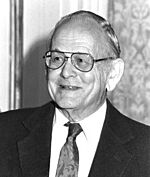Garrett Hardin facts for kids
Quick facts for kids
Garrett Hardin
|
|
|---|---|

Garrett Hardin (1986)
|
|
| Born |
Garrett James Hardin
April 21, 1915 Dallas, Texas, U.S.
|
| Died | September 14, 2003 (aged 88) |
| Alma mater | University of Chicago (BS) Stanford University (PhD) |
| Known for | "The Tragedy of the Commons" (essay) |
| Scientific career | |
| Fields | Ecology |
Garrett James Hardin (born April 21, 1915 – died September 14, 2003) was an American scientist. He studied ecology, which is the study of how living things interact with their environment. He also studied microbiology, which is about tiny living organisms.
Hardin spent much of his career thinking about human overpopulation. This means when there are too many people for the Earth's resources. He is most famous for an essay called "The Tragedy of the Commons". This essay talked about how individual actions can harm the environment. He also had a rule called "Hardin's First Law of Human Ecology". It says: "We can never do merely one thing." This means that anything we do in nature will have many effects, and some are hard to predict.
Some of Hardin's ideas about population and different groups of people were very strong. These ideas led some people to criticize him. They felt his views were unfair or discriminatory towards certain groups. For example, the Southern Poverty Law Center said some of his writings showed ideas about race and nation that were not inclusive.
Contents
Garrett Hardin's Life and Education
Garrett Hardin went to the University of Chicago. He earned a bachelor's degree in zoology in 1936. Zoology is the study of animals. Later, he went to Stanford University. He earned his PhD in microbiology in 1941. His research there was about how tiny organisms live together.
In 1946, he started working at the University of California, Santa Barbara. He became a professor of Human Ecology in 1963. He taught there until he retired in 1978. He was also one of the first members of a group called the Society for General Systems Research.
Key Ideas and Writings
A big part of Garrett Hardin's work was about human overpopulation. He believed there should be strict limits on people moving into new countries. This idea caused a lot of debate and criticism from many people. He also wrote about conservation, which is protecting nature. He also wrote about creationism, which is the belief that the universe was created by a divine being.
The Tragedy of the Commons
In 1968, Hardin wrote his most famous essay, "The Tragedy of the Commons". In this essay, he used an example of herders sharing a piece of land. Each herder wants to add more animals to the land. But if everyone does this, the land gets overgrazed and ruined for everyone.
Hardin used this idea to talk about human population growth. He also applied it to how we use the Earth's natural resources. He argued that if everyone acts only in their own interest, shared resources will be destroyed. He famously wrote, "Freedom in a commons brings ruin to all."
However, some historians and scientists disagreed with Hardin. They said he didn't fully understand how shared resources actually work. For example, Elinor Ostrom later won a Nobel Prize for her work. She showed that communities can successfully manage shared resources together. Her research proved that shared land doesn't always have to fail. She found that people often cooperate to protect their shared resources.
Despite these criticisms, Hardin's "Tragedy of the Commons" idea has been very important. It made many people think about how we manage shared resources.
Living Within Limits
In 1993, Garrett Hardin published a book called Living Within Limits: Ecology, Economics, and Population Taboos. He said this book summarized all his earlier ideas. It won an award called the Phi Beta Kappa Award in Science.
In the book, Hardin argued that science understands limits. For example, the speed of light is a limit. But he felt that some social sciences, like economics, often ignore limits. He pointed out that many economic ideas assume the Earth's resources are endless.
Hardin called people who always push for more growth "growthmaniacs." He argued that constant exponential growth (like a snowball getting bigger and bigger very fast) cannot happen on a planet with limited resources. He used an example of money growing with compound interest. He showed that even a small interest rate over a long time would lead to impossible amounts of money. This means that economies based on endless growth will eventually fail. He also said that population growth is like this too. Even a little growth can cause big problems over time.
Books by Garrett Hardin
- 1949, Biology: Its Human Implications
- 1952, Biology: Its Human Implications, Second Edition
- 1959, Nature and Man's Fate
- 1961, Biology Its Principles and Implications
- 1966, Biology Its Principles and Implications, Second Edition
- 1972, Exploring new ethics for survival: the voyage of the spaceship Beagle
- 1973, Stalking the Wild Taboo
- 1974, Mandatory Motherhood: The True Meaning of 'Right to Life'
- 1977, The Limits of Altruism: an Ecologist's view of Survival
- 1980, Promethean Ethics: Living With Death, Competition, and Triage
- 1985, Filters Against Folly, How to Survive despite Economists, Ecologists, and the Merely Eloquent
- 1993, Living Within Limits: Ecology, Economics, and Population Taboos
- 1999, The Ostrich Factor: Our Population Myopia
Awards and Recognition
- In 1973, Hardin was chosen to be part of the American Academy of Arts and Sciences.
- In 1974, he was elected to the American Philosophical Society.
- His 1993 book, Living Within Limits, won the 1993 Award in Science from the Phi Beta Kappa Society.
See also
- Bioethics
- Commonize costs–privatize profits game
- Earth system science
- Multiculturalism
- Ratchet effect
- Taboo

